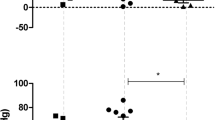Summary
In anaesthetized cats, the intermediate aspect of the nucleus of the solitary tract (NTS) was bilaterally superfused with artificial CSF through push-pull cannulae. The release of the endogenous catecholamines dopamine, noradrenaline and adrenaline was determined in the superfusates radioenzymatically. Blood pressure changes were elicited by intravenous injections of drugs (noradrenaline or chlorisondamine), or electrical stimulation of the intermediate NTS with the tip of the push-pull cannula.
Intravenous injections of noradrenaline (3 or 10 μg/kg) elicited a rise in the arterial blood pressure which was associated with a decrease in the release rate of adrenaline in the intermediate NTS. The release rates of dopamine and noradrenaline were not influenced. The intravenous injection of chlorisondamine (3 mg/kg) lowered blood pressure and diminished the release rate of dopamine in the intermediate NTS. The release rate of noradrenaline was not modified by chlorisondamine. Electrical stimulation of the intermediate NTS contralateral to the superfused nucleus increased moderately the arterial blood pressure and decreased the release rate of noradrenaline and dopamine, while the release of adrenaline was not influenced. The findings suggest that experimentally induced changes in the arterial blood pressure by drugs injected intravenously modify the release rates of adrenaline and dopamine in the intermediate NTS so as to counteract the blood pressure change. In the intermediate NTS, release of adrenaline from adrenergic nerve terminals seems to act hypertensive. The results obtained with chlorisondamine point to a hypotensive function of endogenous dopamine in the intermediate NTS.
Similar content being viewed by others
References
Berman AL (1968) The brainstem of the cat. A cytoarchitectonic atlas with stereotaxic coordinates. The University of Wisconsin Press, Madison
Bhaskaran D, Freed CR (1988) Changes in arterial blood pressure lead to baroreceptor-mediated changes in norepinephrine and 5-hydroxyindoleacetic acid in rat nucleus tractus solitarius. J Pharmacol Exp Ther 245:356–363
Died H, Eisert A, Kraus A, Philippu A (1981) The release of endogenous catecholamines in the cat hypothalamus is affected by spinal transection and drugs which change the arterial blood pressure. J Anton Pharmac 1:279–286
Fuxe K, Agnati LF, Ganten D, Goldstein M, Yukimura T, Jonsson G, Bolme P, Hökfelt T, Andersson K, Härfstrand A, Unger T, Rascher W (1981) The role of noradrenaline and adrenaline neuron systems and substance P in the control of central cardiovascular functions. In: Buckley JP, Ferrario CM (eds) Central nervous system mechanisms in hypertension. Raven Press, New York, pp 89–113
Klausmair A, Philippu A (1989) Carotid occlusion increases the release of endogenous GABA in the nucleus of the solitary tract. Naunyn Schmiedeberg's Arch Pharmacol 340:764–766
Klausmair A, Singewald N, Philippu A (1991) Release of endogenous catecholamines in two different regions of the nucleus of the solitary tract as influenced by carotid occlusion. Naunyn-Schmiedeberg's Arch Pharmacol 343:155–160
Klüver H, Barrera E (1953) A method for the combined staining of cells and fibers in the nervous system. J Neuropath Exp Neurol 12:400–403
Kobilansky C, Lanzinger I, Philippu A (1988) Release of endogenous catecholamines in the nucleus tractus solitarii during experimentally induced blood pressure changes. Naunyn-Schmiedeberg's Arch Pharmacol 337:125–130
Lanzinger I, Kobilansky C, Philippu A (1989) Pattern of catecholamine release in the nucleus tractus solitarii of the cat. Naunyn-Schmiedeberg's Arch Pharmacol 339:298–301
Miura M, Takayama K (1986) The functional subdivisions of the nucleus tractus solitarii of the cat in relation to the carotid sinus nerve reflex. J Auton Nerv Syst 15:79–92
Palkovits M, Brownstein MJ (1989) Catecholamines in the central nervous system. In: Trendelenburg U, Weiner N (eds) Catecholamines II. Springer, Berlin Heidelberg New York, pp 1–16
Philippu A (1988) Regulation of blood pressure by central neurotransmitters and neuropeptides. Rev Physiol Biochem Pharmacol 111:1–115
Philippu A, Przuntek H, Roensberg W (1973) Superfusion of the hypothalamus with γ-aminobutyric acid: effect on release of noradrenaline and blood pressure. Naunyn-Schmiedeberg's Arch Pharmacol 276:103–118
Philippu A, Dietl H, Sinha JN (1980) Rise in blood pressure increases the release of endogenous catecholamines in the anterior hypothalamus of the cat. Naunyn-Schmiedeberg's Arch Pharmacol 310: 237–240
Philippu A, Dietl H, Eisert A (1981) Hypotension alters the release of catecholamines in the hypothalamus of the conscious rabbit. Eur J Pharmacol 69:519–523
Sinha JN, Dietl H, Philippu A (1980) Effect of a fall of blood pressure on the release of catecholamines in the hypothalamus. Life Sci 26:1751–1760
Author information
Authors and Affiliations
Additional information
Send offprint requests to N. Singewald at the above address
This work was supported by the Fonds zur Förderung der wissenschaftlichen Forschung
Rights and permissions
About this article
Cite this article
Singewald, N., Klausmair, A. & Philippu, A. Blood pressure changes modify the release rates of catecholamines in the intermediate nucleus of the solitary tract. Naunyn-Schmiedeberg's Arch Pharmacol 345, 176–180 (1992). https://doi.org/10.1007/BF00165733
Received:
Accepted:
Issue Date:
DOI: https://doi.org/10.1007/BF00165733




